Editor’s note: The Sun Journal received approval from warming center patrons named in this story and identifiable in the photos accompanying this story.
LEWISTON — Outside Calvary United Methodist Church on Sabattus Street a woman is crying.
It’s not clear what she’s crying about, exactly. The state of her life, maybe. The addictions, personal failings and strokes of bad luck that got her to this point.
Whatever brought her to tears, the woman is not alone in her transient sorrow. On this recent March night, she is surrounded by several people, some of them friends, many others strangers.
One thing is clear about the new warming center set up in February at the church nestled into its corner at Bartlett and Sabattus streets. The inhabitants — both the homeless folks and the staff who tend to them — look out for one another.
Angela Berry, 42, and homeless, was one of those who consoled the weeping woman. Now standing in the parking lot and smoking a post-dinner cigarette, Berry agrees that the newly established warming shelter is having a great effect on the homeless population, mainly because of the variety of support that can be found there.
“I’ve had a hard time staying sober, although I’m clean for a month now,” Berry says. “This program helped me to get there. It made me open up my eyes after I hit rock bottom. I’m real glad this place is here now. There are a lot of people here who support me. They cheer me on and keep telling me I can do it, so now I’m excited for myself.”
Max Robitaille is a 27-year-old who was working and living in his apartment in Auburn when he came over to Lewiston and graduated from marijuana to crack cocaine.
Within six months, he had lost everything, including the job, the apartment and his cat Dusty whom he loved so much.

Paul Bernard takes trays of donated desserts out of his car trunk as others smoke and hang around last week at the warming center at Calvary United Methodist Church on Sabattus Street in Lewiston. Russ Dillingham/Sun Journal
“I went from sleeping in cardboard boxes to sleeping in dumpsters,” he says, “then to sleeping in the woods with a tent and sleeping bag. Sometimes I’d sleep at a friend’s house. A lot of the time I’d sleep in hallways. Any place I could find, really.”
The new warming center, with an experienced staff behind it, opened in mid-February. Homeless people showed up in droves, for food served at 10 p.m., for sleep in an upstairs room, or for help with their addictions or mental health problems.
“This is the best place I’ve found since I became homeless,” Robitaille says. “Instead of just struggling on the street and maybe freezing to death without anyone or any place to help me, I got this church right here right now.”
A BRIEF HISTORY
Last year, a warming center at the Calvary church was run by The Immigrant Resource Center along with Community Concepts. While it succeeded in keeping people out of the winter cold, the new project was met with criticism from several fronts over its impact to the neighborhood.
This year, officials in Lewiston and Auburn, who are funding the current effort, went in a new direction, accepting a bid from Kevin Boilard, director of Kaydenz Kitchen.
Part of that move was based on the fact that Boilard is a known quantity. He has worked more than a decade helping the homeless community. He has a rapport with them.
Part of it was due to Boilard’s proposed budget, which was lower than those offered by other groups.

A homeless person tries to find her bedding last week at the overnight warming center inside Calvary United Methodist Church on Sabattus Street in Lewiston. Visitors are allowed to store their blankets and bedding during the day so they don’t have to carry things around with them. Russ Dillingham/Sun Journal
Last year’s food budget alone, for example, was around $3,000 a week.
“In our proposal, we put down $500 a week for food and people just kind of chuckled and laughed,” Boilard says. “But we’re a food pantry. One thing we should be resourceful in is food, so we were entertained by the fact that people were doubting us. That just gave us a little more fire to show them that it could be done.”
The shelter has a staff of nine, including a core group with plenty of experience in working with the homeless population. In addition to Boilard, veteran homeless advocates Megan Parks, Kimber Sands, Tonya Sands and Jamie Caouette are on the team, all familiar faces from previous moves to help the unhoused.
It is the same team that first proposed a 24-hour shelter and resource center over two years ago — a plan rejected by the previous City Council. The group is planning to present another proposal to the council.
“We’ve proven ourselves time and again,” Parks says. “This work is our passion and we do it well. And we won’t stop until Lewiston has the 24-hour homeless resource program that is long overdue.”
In the meantime, there is the temporary warming shelter, which will continue operating until April 9. So far, it’s functioning smoothly by most accounts.
Boilard’s staff includes a security officer who keeps the peace when necessary. Problems are dealt with swiftly, for the sake of the homeless folks seeking succor inside the church as well as the people who live in the vicinity of the church.
“We’ve had our challenges on certain nights,” Boilard says. “You do see certain levels of intoxication. We never refuse anyone entry. What we do is we invite them in and advise them to be respectful — to be appreciative and grateful for the opportunity. But at the same time, if they get a little too rowdy or if they make guests or staff feel unsafe, then we just ask them to leave for the evening or for several evenings, depending on what the infraction is.”

Paul Bernard gives a homeless man whoopie pies last week at the warming center inside Calvary United Methodist Church on Sabattus Street in Lewiston, after learning the night before he was craving them. Russ Dillingham/Sun Journal
GETTING PERSONAL
On this Thursday night in mid-March, though, there are no hints of trouble. Although populated by dozens, things are almost preternaturally quiet both inside and out.
Since it opened, the warming shelter has been averaging about 60 people a night, and this night is no different. By 10 p.m., there is a thick crowd of homeless people milling around in the parking lot, waiting for the doors to open.
Some come with shopping carts heaped high with whatever possessions they have gathered during their time on the streets. One woman brings a plastic bag containing yarn and needles and whenever there is a free moment, she gets to knitting.
The youngest of them is a 24-year-old woman. There are one or two men in their 70s at the shelter tonight, but the mean age of the group appears to be between 30 and 50.
In the parking lot, there is quiet chatter. Most seem to know one another. A few are strangers who stand off to the side, quietly assessing the others.
The doors open promptly at 10 p.m. Once inside, the men and women who came for food and shelter will be offered food from an array of sources.
Paul Bernard, one of the servers, routinely takes photos of the crews who prepare food for the shelter and posts them on Facebook with updates about the goings-on there.
“Saturday, our chef Sean Stanton brought in his famous chili, which did not last long,” Bernard wrote recently. “It was good to the last drop. We had food from Rusty Lantern, Bates College, Saint Dom’s, Pathway Vineyard and another donation from the mosque. One thing for sure the homeless are being well fed. The numbers of those coming to eat is increasing as the word is getting out that there is good healthy food at Kaydenz Kitchen Food Pantry, warming center in Lewiston.”

A homeless person eats last week across from the overnight warming center inside Calvary United Methodist Church on Sabattus Street in Lewiston where they serve a free hot meal. There are a few people who come to get food and leave the church grounds. Staff monitors this and if they choose to leave the church property, they can not come back until the next night. Russ Dillingham/Sun Journal
On the menu tonight are hamburgers, hot dogs, chicken strips and salad. The shelter denizens wait in an orderly line that stretches back to the door. The line moves quickly as people fill up their plates.
“They have really good food here,” says Robitaille, who takes his tray to a table to sit with friends he’s made on nights like these.
In the food line, the servers are pleasant and their cheerful demeanor is met with politeness from the men and women being served. There seems to be mutual respect at work here. There is a certain comfort of familiarity on both sides of the serving line.
When Riechelle Rogers Bernard serves up food to someone in line, it’s a personal affair.
“I ask them their name. I ask how they’re doing. We’re building relations with them,” she says. “We’re building trust.”
At night, she sits down with the men and women who aren’t tired enough to go upstairs for sleep. She plays board games with them. Talks to them about their problems. She takes pictures of those who are willing and further establishes relationships with them.
When you watch Bernard and the other staff members work, you can tell that they are here because they want to be. They are earnestly invested in helping the homeless population, even if some of them admit it wasn’t always that way.
“My perspective on the homeless has changed drastically over this past year that my husband Paul and I have been helping out,” Bernard says. “We were in Lewiston by Kennedy Park when I saw homeless hanging around. I used to be very quick to judge people at first glance — quick to put homeless all in one box and say ‘they are all drug addicts and drunks.’ Some I felt scared or uncomfortable to be near by how they looked or acted so it’s easy to look away.”
Now, Bernard is so fond of the people she serves, she has become invested in their lives. All told, she has at least 160 photos she has taken with the men and women who come to the shelter. Not long ago, Bernard and her husband spotted one of them, a woman known as Cream Puff, wandering in downtown Lewiston.
They knew it was Cream Puff’s birthday, so they got out of their car and stood there on the street singing happy birthday to her. It’s a memory Bernard speaks of with great fondness.

Some staff members talk before the doors open last week at the warming center inside Calvary United Methodist Church on Sabattus Street in Lewiston. From left are Linda Doucette Scott, Tonya Sands, Jessica McKenzie, Kevin Boilard and Kimber Sands. Russ Dillingham/Sun Journal
A POSITIVE SPIN ON THINGS
But the fact is that many of those who come to the shelter suffer a variety of problems. Some are addicted to drugs. For others it’s alcohol. Some have mental illnesses coupled with addiction.
Staff members are trained to address these kinds of social issues and offer resources. It’s a step up from previous efforts in which homeless people were offered food and shelter but little else.
“When we look at this versus what’s happened in the past,” says staffer Linda Scott, “we’re looking at staff that has training in de-escalation, training in substance abuse, training in behavioral health. I think it has made a significant difference in making sure that this is being run successfully.”
The homeless men and women who come to the shelter seem to thrive off the sense of routine that is offered.
“The structure of the program allows them to come in and get the food resources and the relaxation of the warming center resources without too many challenges,” says Boilard. “We have that second floor, which is kind of the quiet area. People can unfold and relax up there. It’s an inside voices kind of space, so it really gives them an opportunity to unwind and de-stress from the streets.”
Roughly 35 people a night take advantage of the upstairs space, Boilard says. On this night, a half-dozen people retreat to that space immediately after eating dinner downstairs. By 10:30 p.m., they are already asleep under blankets in that dark, quiet room on the upper floor.
Downstairs, most are done with their meals. They sit around tables, chatting with others or taking care of small problems they couldn’t get to while out on the street. Some roll cigarettes and tuck them away for later. Others make repairs to torn clothing or tattered shoes.

Homeless people prepare for the night last week at the warming center inside Calvary United Methodist Church on Sabattus Street in Lewiston. Russ Dillingham/Sun Journal
A few exchange war stories, describing all the misadventures they have experienced since becoming homeless. They share secrets: about what parts of the city to avoid at which times of day, about where the food is good, and about where the best sleeping spots are.
Some retreat outside for smokes before settling in for the night. Out there, with the sounds of the city around them, a few become reflective about their lives and about what went wrong.
Berry, the 42-year-old homeless woman in her first month of sobriety, recalls living in a tent in the woods near Sunnyside Park a mile away. That homeless encampment was one of several eventually razed by the city.
“I went to work one day and when I came back, all my stuff was gone,” Berry says. “Even my cat. They threw everything in the trash. Then the city went in there with bulldozers and they knocked everything down.”
She’s been sleeping in various places since, Berry says. During the coldest part of winter, she suffered frostbite on all of her toes.
Berry observes that there are more homeless people in Lewiston than she’s ever seen. Many of them, she says, have come from Portland. Others have come from northern parts of the state where resources for homeless people are in short supply.
“It’s just really, really sad,” she says. “I tell them, there’s not much in Lewiston, either.”
She hasn’t found much luck getting help from City Hall since the system is so overburdened, Berry says. She is extremely grateful for the new shelter at the church, she says, and she’s also optimistic about the future.
“My best bet is go get a job and save up some money while this place is still open,” Berry says. “If I can save up enough, I can get my own room. Right now I’m collecting bottles and cans so I can get my cigarettes. I’ve got to do what I’ve got to do.”

Visitors eat a late-night dinner last week at the warming center inside Calvary United Methodist Church on Sabattus Street in Lewiston. Russ Dillingham/Sun Journal
Robitaille, the 27-year-old, says he uses his time at the shelter to try and help other addicts to get into recovery. He tells them about the program Recovery Connections Maine and shares his own experience in battling addiction.
“A lot of people here want to get into recovery,” Robitaille says, “but they just don’t know how to do it. So I just try to push them with any kind of motivation I’ve gotten myself and I try to get them where they need to be.”
Robitaille is hoping to get a job with a new restaurant opening in Auburn so he can start getting his life back on track.
Meanwhile, a 54-year-old man who goes by Lolo is giving the weeping woman a pep talk. Stay positive, he tells her. Think about the good things in your life.
It seems to work. The woman stops crying, and a few moments later she’s chipper again and talking excitedly with some of the others.
Lolo gets it. Being homeless is horrible, he says. When the full impact of your situation hits you square in the face, it can be overwhelming.
But he says a good attitude is the first step out of it.
“You just try to stay uplifted,” he says. “I thank God for the things I don’t have, like leukemia or something like that. It’s too easy to think about the bad things, the negative things in your life all the time. If you speak negative, negative is what you’ll get back. I try to teach people that. When I wake up, I try to find three things to be thankful for. Every morning. Sometimes it’s hard.”
Like the others, Lolo is grateful for the new shelter. He likes the food and the fact that the staff treats homeless people with respect.

Riechelle and Paul Bernard joke with visitors while serving food last week at the warming center at Calvary United Methodist Church on Sabattus Street in Lewiston. Russ Dillingham/Sun Journal
THE GOOD, THE BAD AND THE ONGOING EFFORTS
With the new warming shelter a few weeks into operation now, the project is by and large being hailed as a success.
But not everyone is a fan. As they have with previous shelter efforts at Calvary, some neighbors continue to complain about evening noise, litter and even thefts in the area around the shelter.
“There is yelling all night,” writes one woman who lives nearby. “Fighting, litter everywhere. An ambulance comes at least three times a week in the middle of the night and it’s like a party all night long with no supervision.”
The woman says she sympathizes with the homeless clients and would like to see them get a permanent shelter somewhere. But at the same time, she says she’s been threatened with bodily harm outside her home, items have been stolen off her porch and her grandchildren are awakened each night by noise coming from the church.
According to Linda Scott, plans are in the works to address these problems. Shelter staff members have been getting together on weekends, for instance, to clean trash in the neighborhood. Staying in touch with the people who live in the area has always been a part of the plan.
It’s clear shelter officials want everyone to be happy with the latest effort to help the homeless population. The plan won’t work, otherwise.
“We have spoken to neighbors and encourage them to reach out to staff so that we may address any issues as best we can,” Scott says. “When we focus on what the whole community needs and not just what’s happening here, I think we’re going to be more successful.”
Paul Bernard, at 72, works to exhaustion at the shelter with his wife, Riechelle. In a recent Facebook post, he ruminated about the rigors of feeding homeless people day after day balanced by the immense reward of helping those in need.
“… Our feet hurt at the end of the day when we return home at 1 to 2 a.m.,” he wrote on March 12, “your legs hurt, you have a slight headache nearly every night, your hands, arms and shoulders and back ache because of standing on a cement floor so long. These are things never mentioned in serving those in need — those who are thirsty, hungry, in need of shelter and clothes and mostly, they need to know someone cares and that they are important to God and to us.”

Staff member Tonya Sands, right, pets a dog last week at the warming center at Calvary United Methodist Church on Sabattus Street in Lewiston. Sands was checking homeless visitors in but could not allow this woman to enter because pets are not allowed inside. Russ Dillingham/Sun Journal
Send questions/comments to the editors.

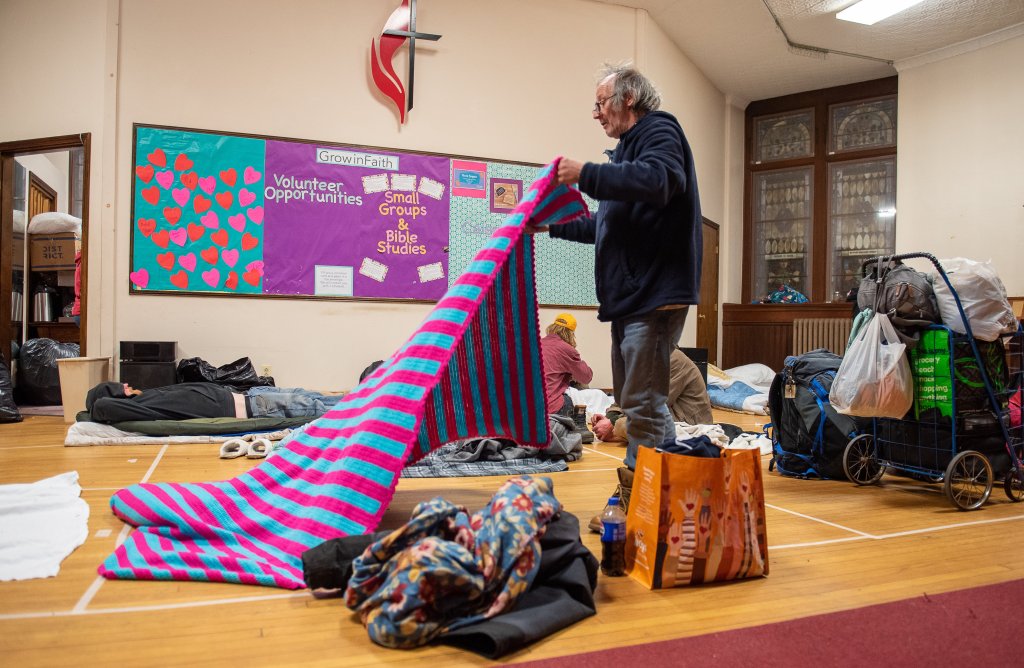

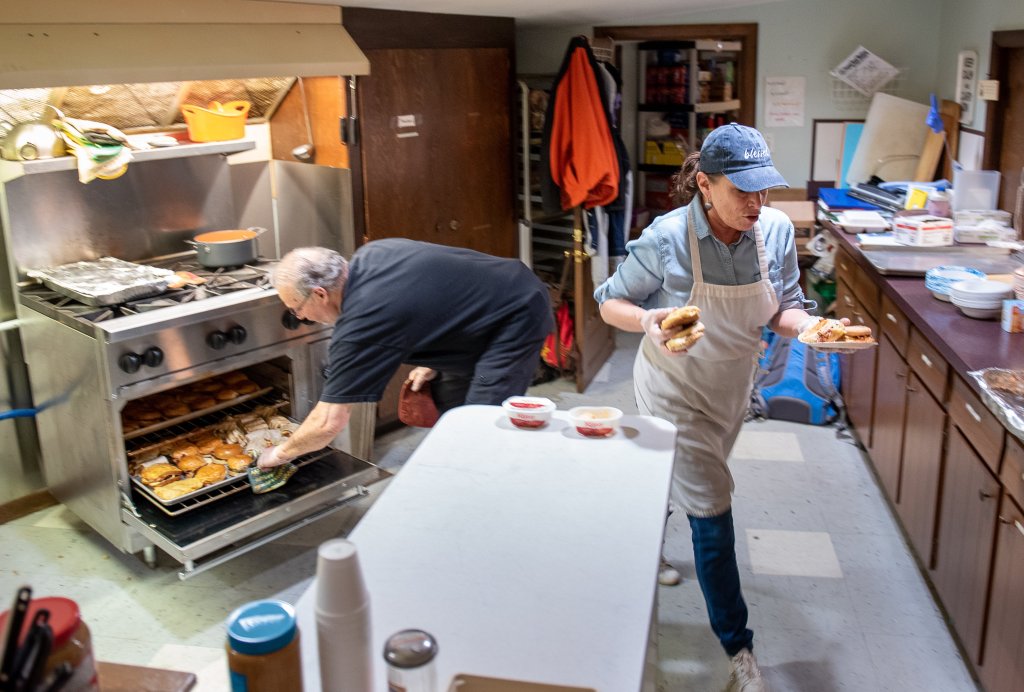
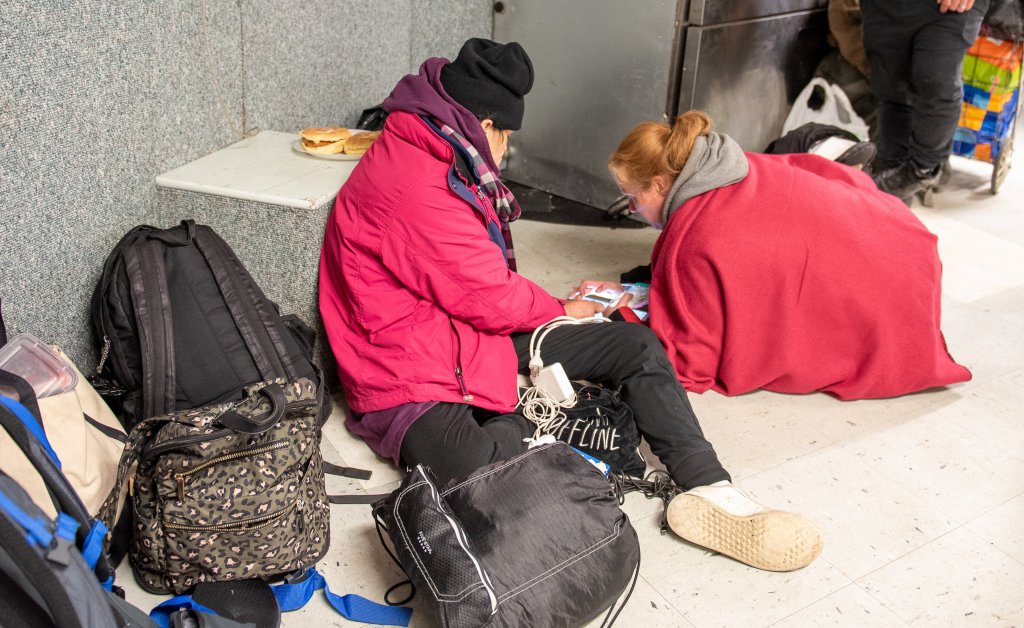
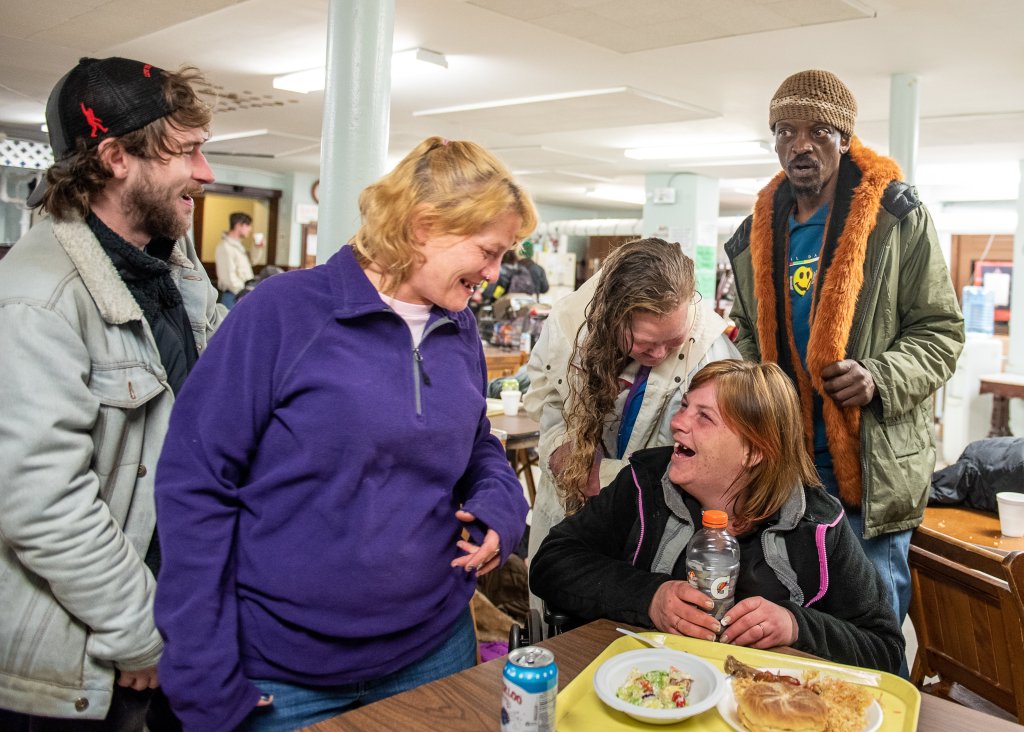
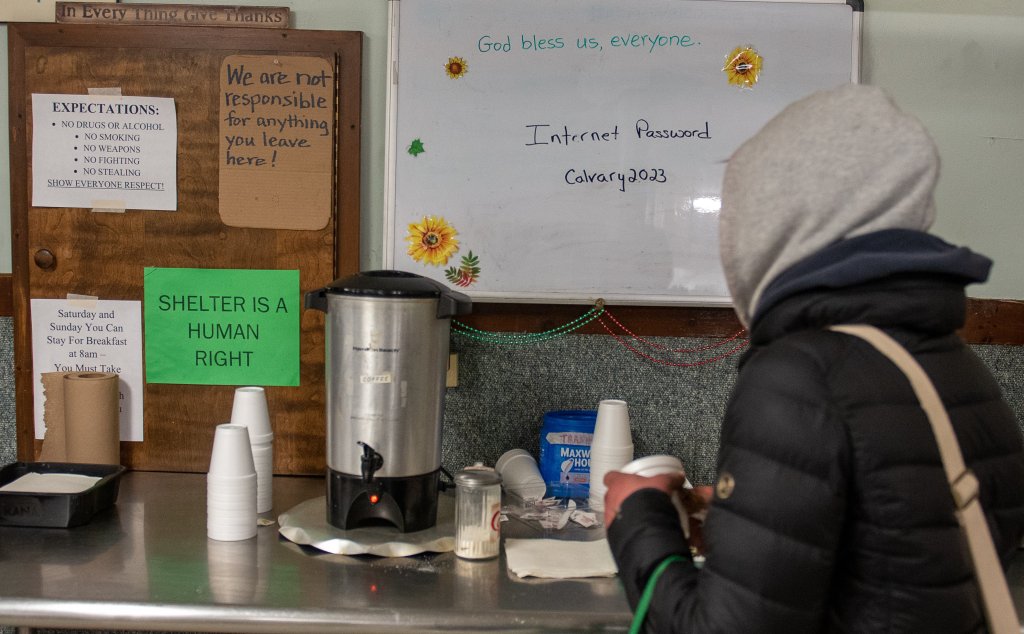
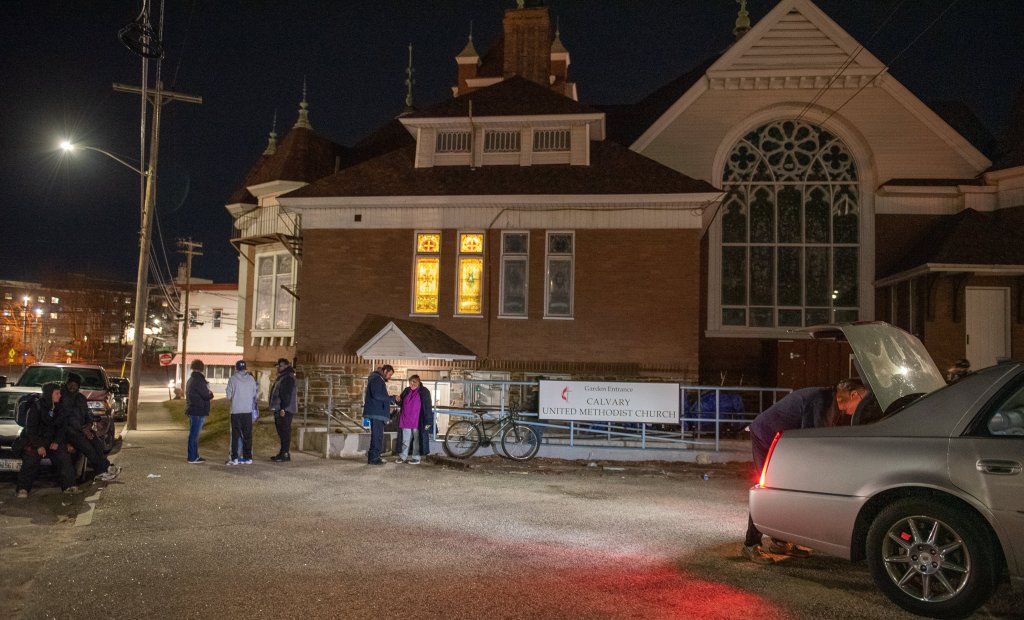
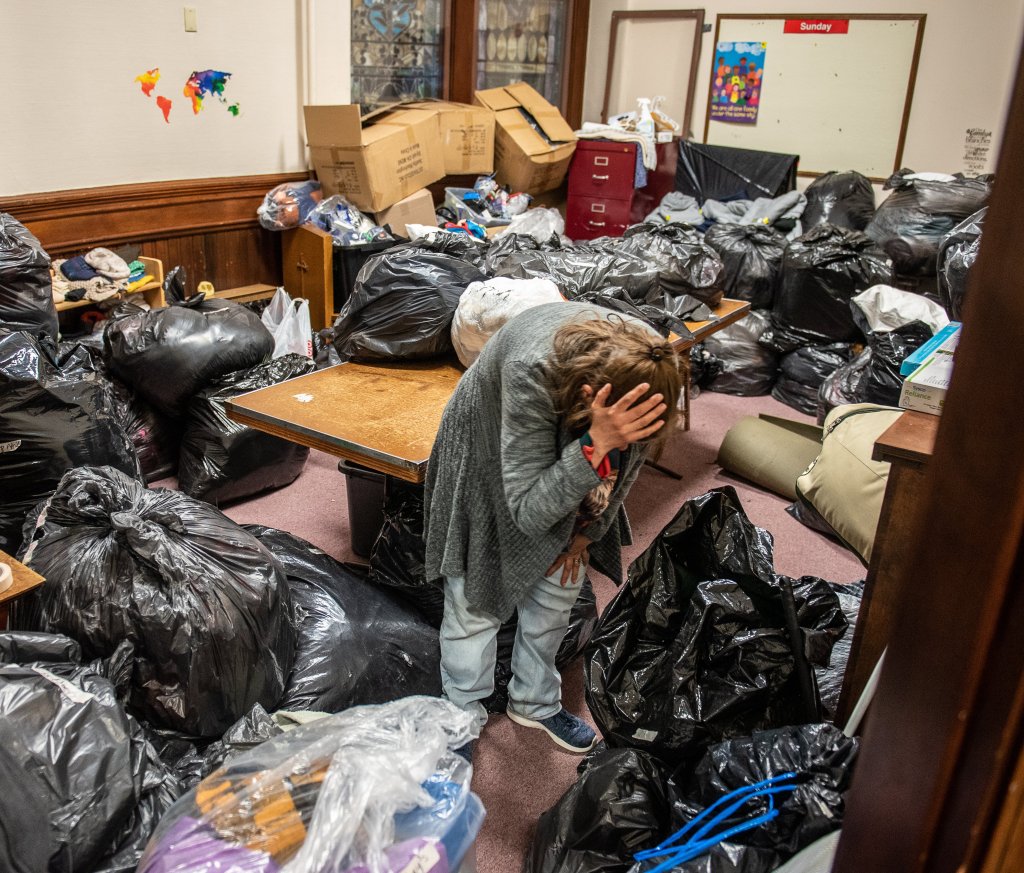
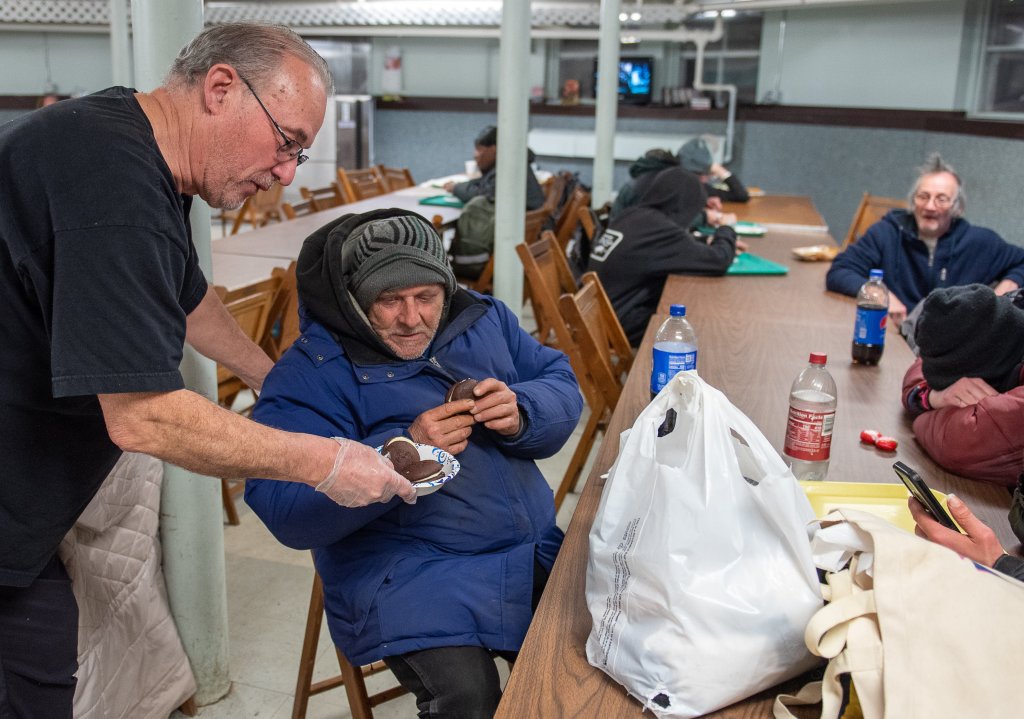
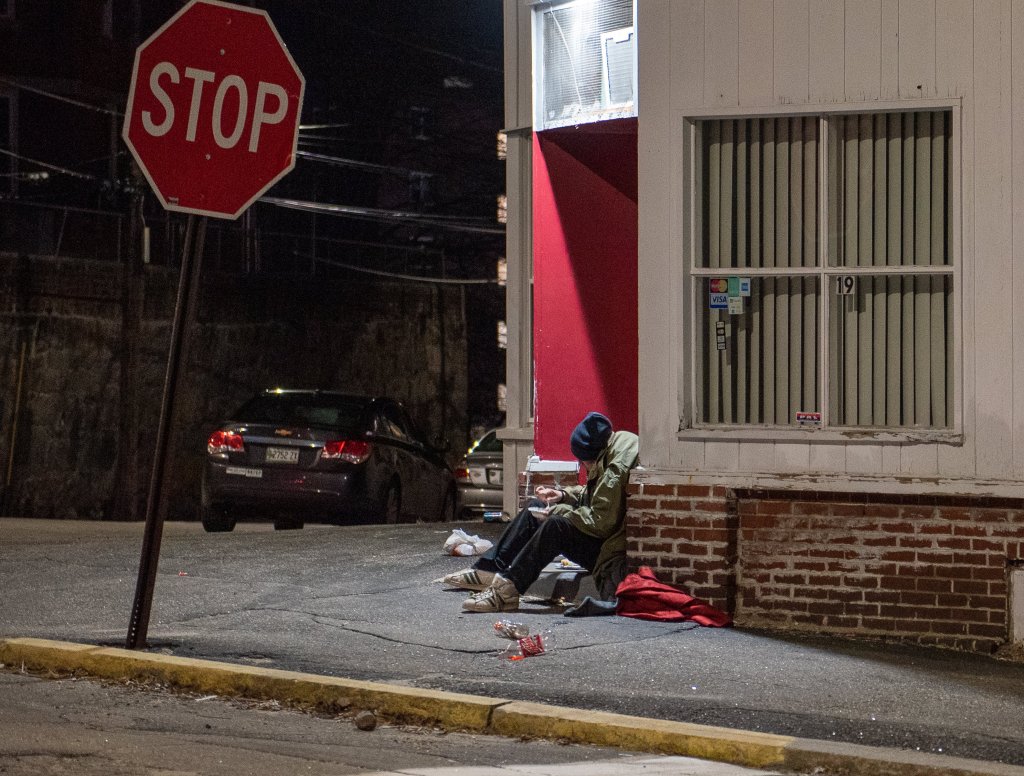
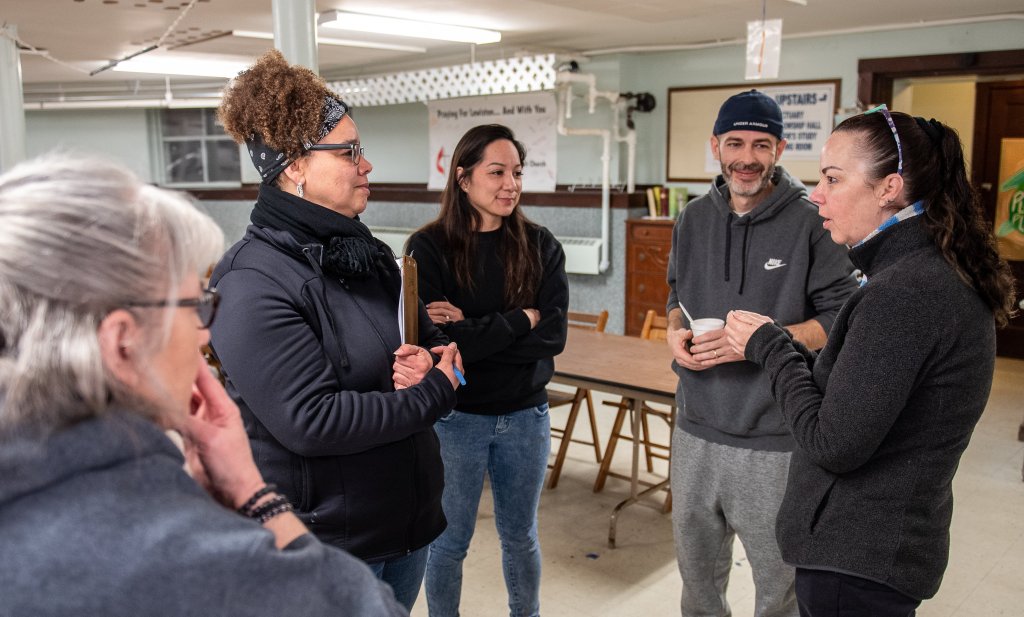

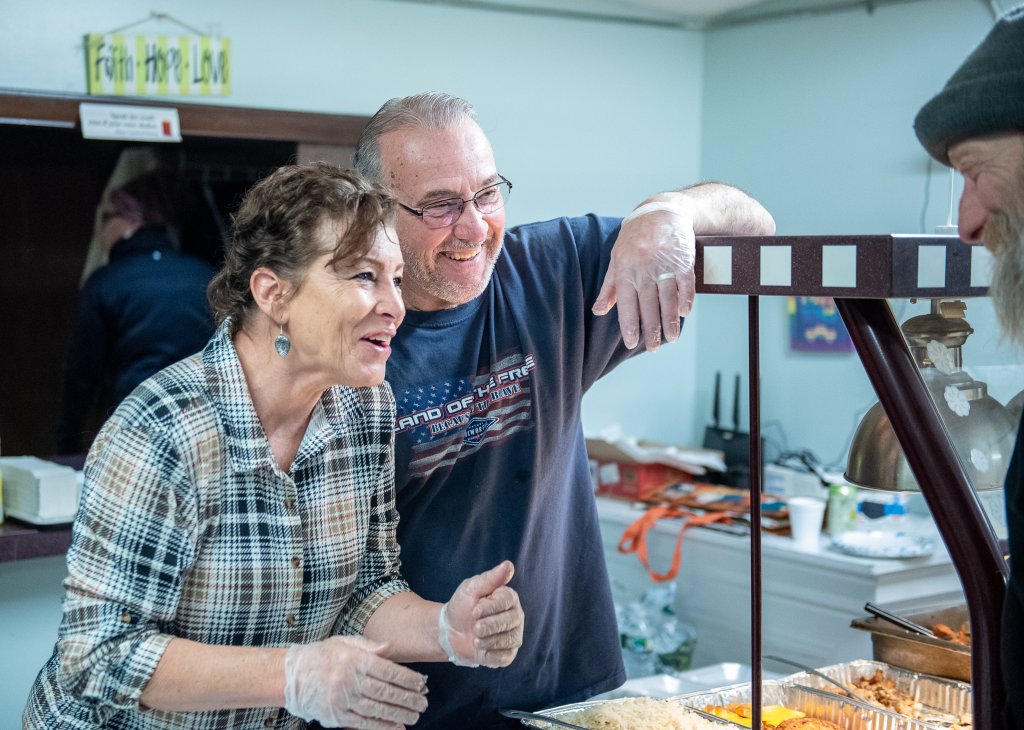
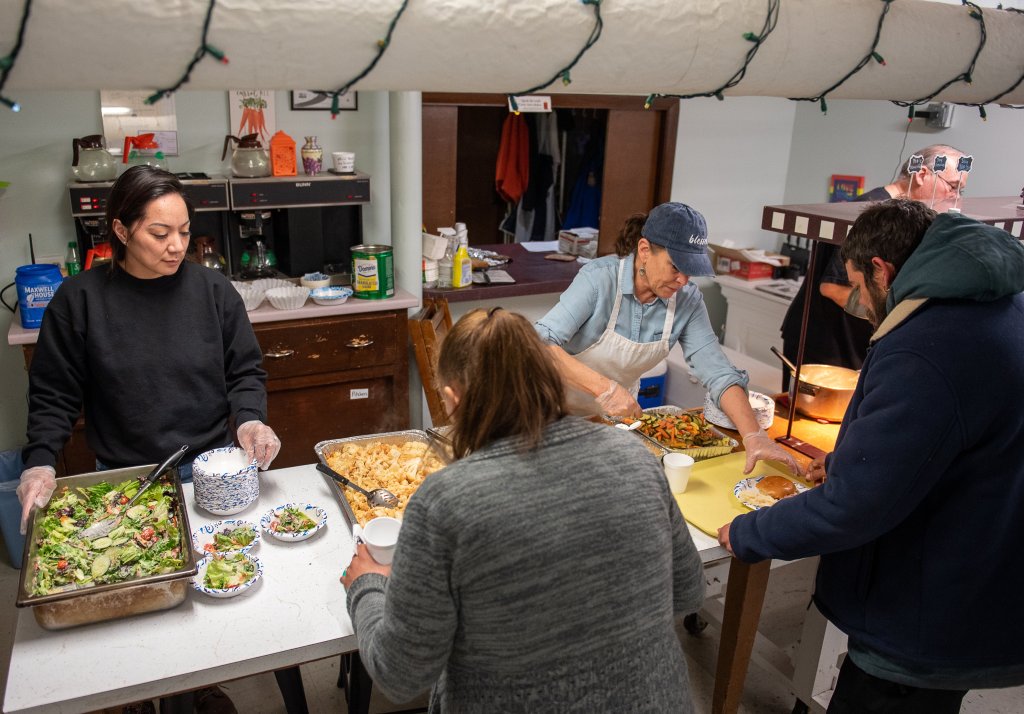
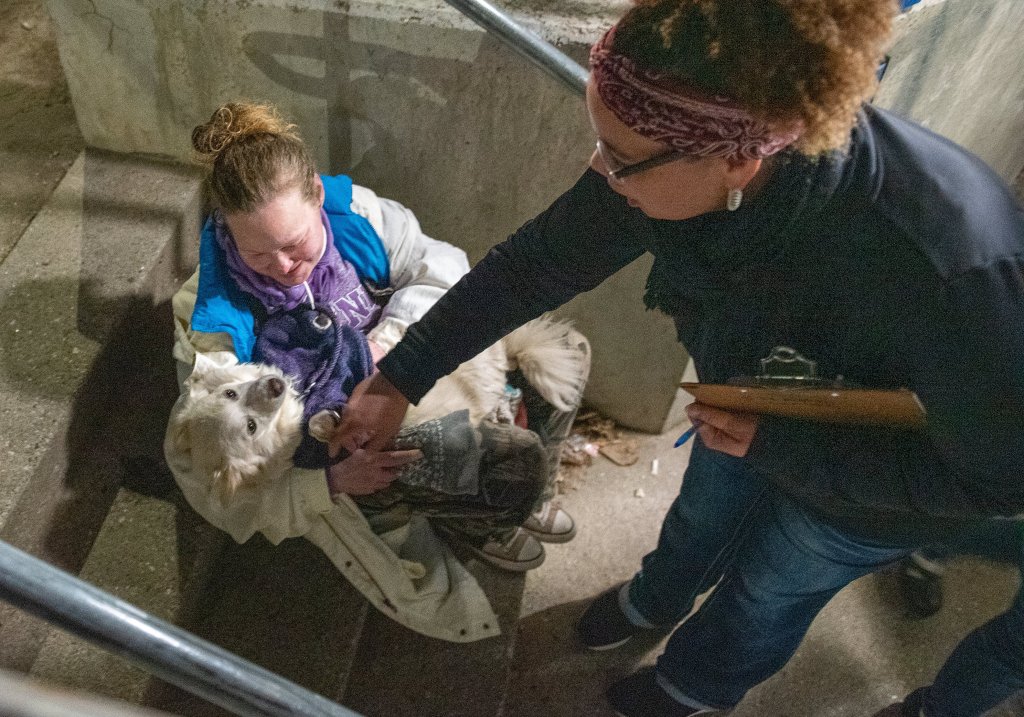
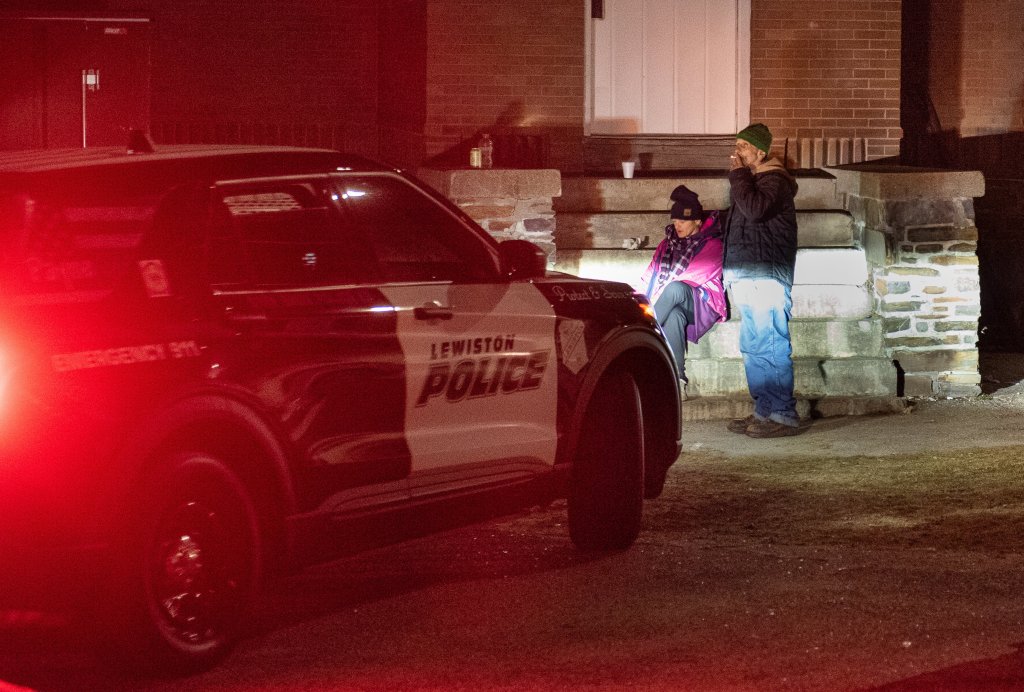
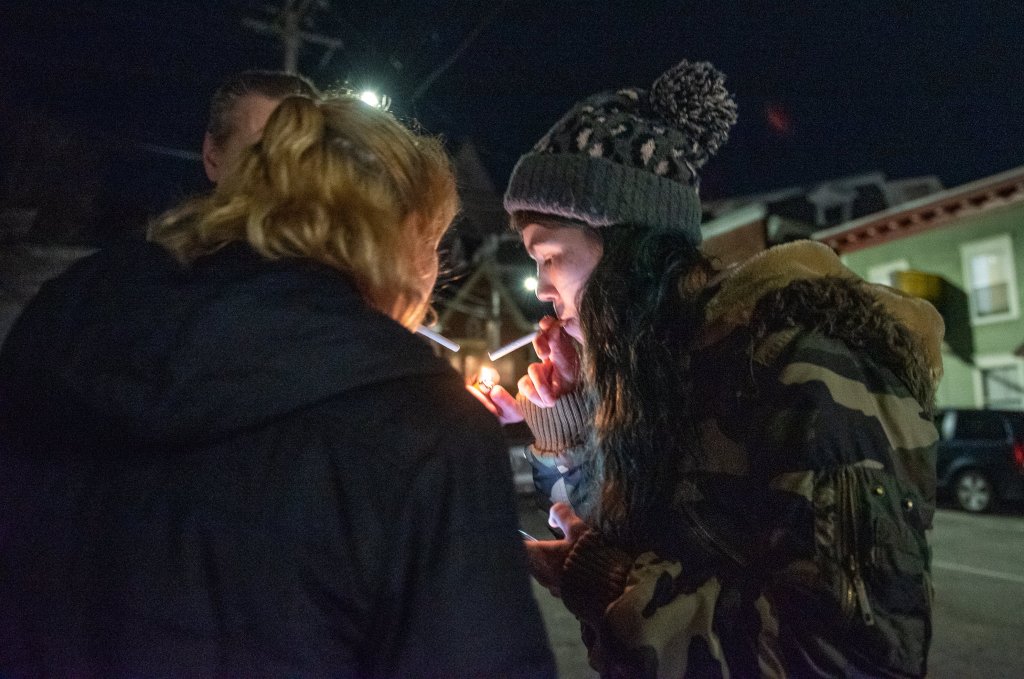
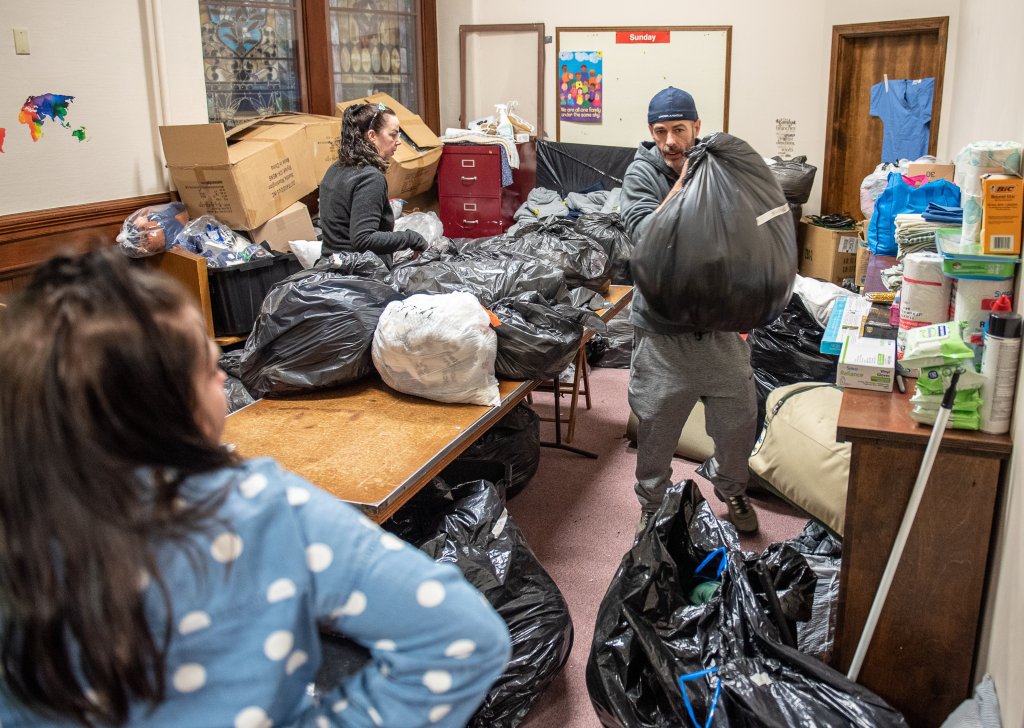
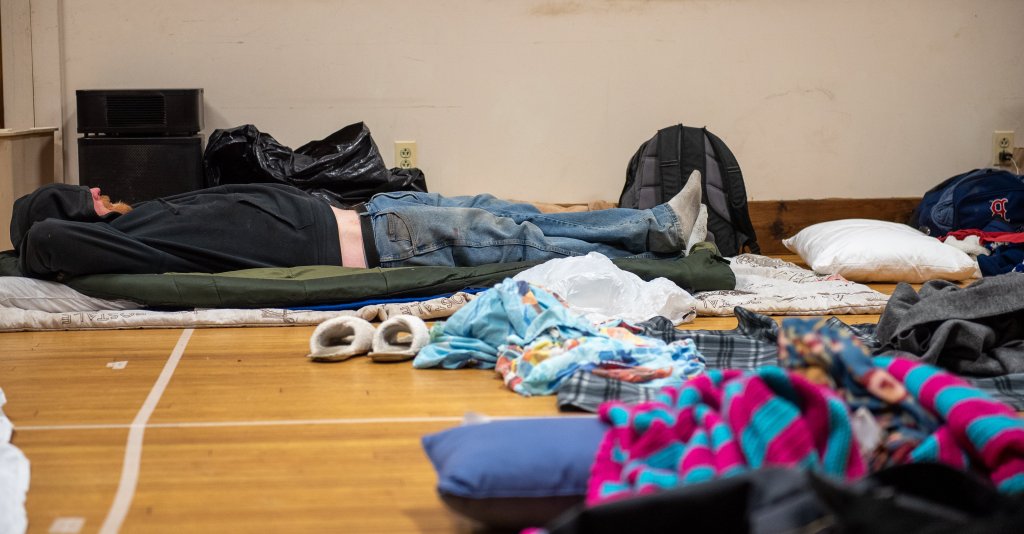
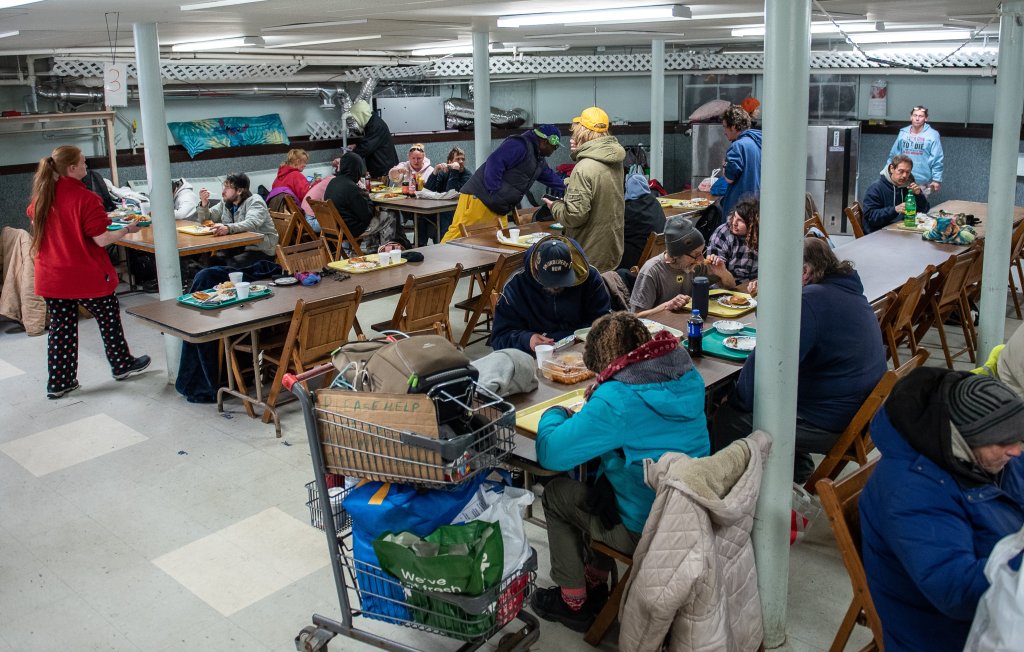

Success. Please wait for the page to reload. If the page does not reload within 5 seconds, please refresh the page.
Enter your email and password to access comments.
Hi, to comment on stories you must . This profile is in addition to your subscription and website login.
Already have a commenting profile? .
Invalid username/password.
Please check your email to confirm and complete your registration.
Only subscribers are eligible to post comments. Please subscribe or login first for digital access. Here’s why.
Use the form below to reset your password. When you've submitted your account email, we will send an email with a reset code.